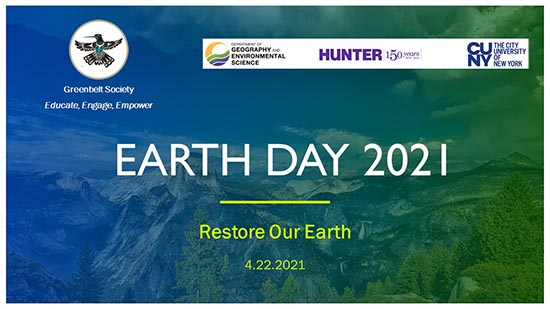Virtual Event

Earth Day Conference: Environmental Restoration
Thursday, April 22, 2021
1:00 to 3:00 PM Eastern Time (US and Canada)
PROGRAM:
I. Welcoming Remarks by Natalie Monterrosa
II. Keynote Presentation: "What is an Ecological Restoration?" by Enrique Lanz Oca
III. Panel I (10 minutes each)
- "Preventing Bird Strikes at Hunter College," presented by Alyssa Bueno, Hunter College
- "Survival & Resilience: 2021 Year of Uncertainty," presented by Rafael de Balanzo and Vanessa di Ferrari, The Compost Collective
- "Water Pollution in NYC," presented by Jingyu Wang, Department of Geography and Environmental Science, Hunter College
IV. Break (5 minutes)
V. Panel II (10 minutes each)
- "Bronx River Corridor," presented by Emily Li, Bronx River Alliance
- "Soundview Oyster Habitat Restoration Project," presented by Carolyn Khoury, Billion Oyster Project (Restoration Program Manager)
- "Elwha Restoration (Root) Tips for Recovery," presented by Howard Sprouse and Jenise Bauman, Western Washington University and The Remediators Incorporated
VI. Closing Remarks by Acting Chairperson William Solecki
VII. Open Discussion / Q&A
List of Speakers & Presentations:
Preventing Bird Strikes at Hunter College
Speaker: Alyssa Bueno
Affiliation: Hunter College
Description: The Green Initiative Fund is working to prevent window collisions of migratory birds at one of Hunter's skywalkways where we have observed bird imprints. We have currently proposed to install bird-safe decals and are working with Feather Friendly to pilot a new low-cost, easy to install solution. For this presentation, I would like to discuss the issue of bird collisions (the 2nd largest contributor to bird mortality), conservation work being done in NYC, and the overall project at Hunter. I am also speaking with a few people at Greenbelt to brainstorm ways we can implement other projects at the same time, such as green roofs and vertical plantings.
Survival & Resilience: 2021 Year of Uncertainty
Speakers: Carlos Pesantes, Rafael de Balanzo, Renee Rivera, Vanessa Di Ferrari
Affiliation: The Compost Collective
Description: The Compost Collective is reusing and turning a neglected parcel that belongs to the MTA abandoned infrastructure in the last 50 years into a collective project to get a sustainable future in Queens. The Compost Collective is a local grassroots volunteer community organization with a mission to propagate environmental education and citizen science and community activism through the sequestering of carbon dioxide and methane from our atmosphere through the use of artisanal composting methods, soil amending and planting. Our goal is to reconnect our community with the land and to provide environmental stewardship opportunities to our community.
Water Pollution in NYC
Speaker: Jingyu Wang
Affiliation: Department of Geography and Environmental Science, Hunter College
Description: Combined sewer overflows (CSOs) are major pollution sources in NYC rivers. CSOs discharge stormwater runoff mixed with untreated sewage directly into rivers in NYC during rainstorms, consequently elevatingbacteria and nutrient levels and degrading water quality. This threatens fish consumption safety and impacts the environmental ecosystems in NYC waterways.CSO water samples were collected during heavy rainstorms and dry days in the Harlem River, Hudson River, East River, Bronx River, Gowanus Canal, and Van Cortland Creek.Results show elevated nutrient and pathogen levels (enterococcus maximum 65,000 MPN/100ml) in the Harlem River during rainstorms exceeding NYC DEP regulated levels. During the pandemic lockdown in 2020, ammoniaconcentration (maximum value 5.34 mg/L)increased over pre-pandemic levels in the Bronx residential section along the Harlem River, perhaps caused by more residents staying home. Nutrient and bacteria levels in the Harlem River were higher than the Hudson River, Bronx River, Van Cortland Creek and Gowanus Canal. The goal of this research is to make the Harlem River and all NYC rivers swimmable and fishable.
Bronx River Corridor
Speaker: Emily Li
Affiliation: Bronx River Alliance
Description: Currently interning for the Bronx River Alliance, aiding with the improvement and restoration of the Bronx River Corridor, so that it can be a healthy recreational, educational, ecological, and economic resource for adjacent communities. Involves promoting community engagement and interest through online tools and platforms. Designed interactive virtual story maps using ArcGIS/QGIS, focusing on water quality monitoring data and the disparity between upstream and downstream areas along the river.
Soundview Oyster Habitat Restoration Project
Speaker: Carolyn Khoury
Affiliation: Billion Oyster Project (Restoration Program Manager)
Description: Installed in the summer of 2020, the Soundview Oyster Habitat Restoration Project created 5 acres of oyster reef habitat adjacent to the mouth of the Bronx River by 2022. Funded by the New York State Department of Environmental Conservation (DEC), this project follows on the success of research projects initiated by the NYC Department of Parks and Recreation in 2005, and pilot projects in 2010 and 2012 conducted by current project partners. Soundview was identified as an optimal location for large-scale reef restoration in New York Harbor and increasingly larger reef habitat enhancements. This project will also measure ecosystem services provided by the restored oyster reef and create opportunities for the public to participate in this restoration effort with hands-on, interactive learning experiences. Project partners include the Hudson River Foundation, NY/NJ Baykeeper, NYC Department of Parks and Recreation, Rocking The Boat, and the Bronx River Alliance, with Billion Oyster Project as the project lead.
Elwha Restoration (Root) Tips for Recovery
Speakers: Howard Sprouse, Jenise Bauman
Affiliation: Western Washington University and The Remediators Incorporated
Description: Forest corridors are composed of diverse groups of plants and fungi that structure food webs, produce large woody debris, stabilize soil, cycle nutrients, buffer temperatures, and create wildlife habitat. Dam removal, in efforts to restore riverine systems, expose nutrient poor sediment with low fertility and low water holding capability, which may require active restoration to ensure forest recovery. Native conifers used in plantings, such as Douglas fir and grand fir form beneficial ectomycorrhizal (ECM) symbioses with root colonizing fungi. This project seeks to better understand the relationship between restoration methods and the interaction between ECM and conifer seedlings.
For more information, contact Greenbelt Society at greenbeltsociety1@gmail.com.
All are invited to attend!
Register in advance for this meeting:
https://pratt.zoom.us/meeting/register/tJApcuGqrzktEtyVcB3_p1mDDkB6amRbpX0r
After registering, you will receive a confirmation email containing information about joining the meeting.

